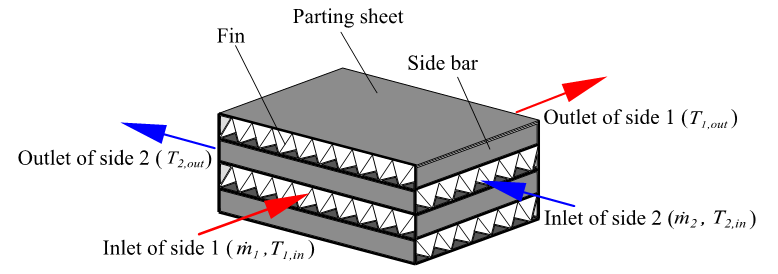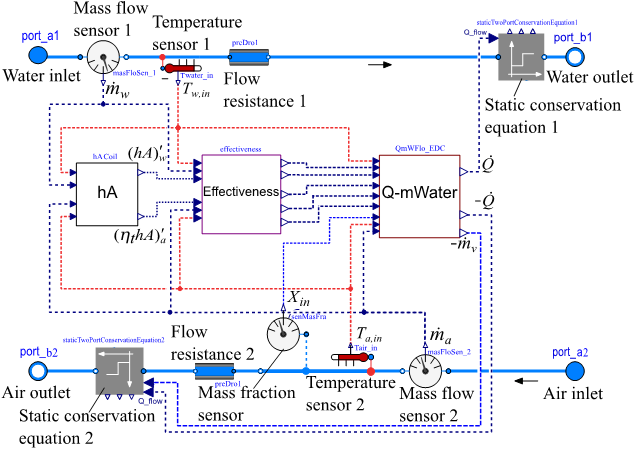Modeling Air-to-Air and Finned-Tube Heat Exchangers

This study is objective to develop a new model for air-to-air plate-fin heat exchanger without dehumidification and a new water-to-air finned tube heat exchanger model. Both models have the features of high accuracy, fast simulation speed, and convenience for setup.
The new model for air-to-air plate-fin heat exchanger without dehumidification adopts correlations of the heat transfer factor and the friction factor, which makes the calculation results of heat transfer and pressure drop closer to real cases. The new water-to-air finned tube heat exchanger model adopts a wet-dry transformation method, which is faster than the numerical models and simpler than the analytical models.
Based on the testing results, both models are computationally efficient and relatively accurate by comparing with the existing models. Furthermore, the new models only require nominal data as inputs, which is convenient for users to set up.

Fig.1 - Energy system from the Modelica simulation tool

Factsheet
| Number of buildings | - |
| Number of thermal zones (per building) | - |
| Complexity of thermal zone model | - |
| Coupling/Decoupling between district network and buildings | - |
| Simulation tool | Dymola |
| Modelica libraries | Buildings |
| Additional packages/workflows/scripts | - |
| Simulation time | One year |
| Computational time | 200 s |
| Solver and tolerance | Dassl / 1e-6 |
| CPU speed | 3.07 GHz |
Authors:
Yunyang Ye (University of Colorado at Boulder - USA)
Guang Zhou
Jing Wang (University of Colorado at Boulder - USA)
Wangda Zuo (University of Colorado at Boulder - USA)
Yunyang Ye (University of Colorado at Boulder - USA)
Guang Zhou
Jing Wang (University of Colorado at Boulder - USA)
Wangda Zuo (University of Colorado at Boulder - USA)
References:
[1] Zhou, G., Y. Ye, Wangda Zuo, X. Zhou, and X. Wu. "Fast and efficient prediction of finned-tube heat exchanger performance using wet-dry transformation method with nominal data." Applied Thermal Engineering 145 (2018): 133-146.
[2] Zhou, G., Y. Ye, J. Wang, Wangda Zuo, Y. Fu, and X. Zhou. "Modeling air-to-air plate-fin heat exchanger without dehumidification." Applied Thermal Engineering 143 (2018): 137-148.
[1] Zhou, G., Y. Ye, Wangda Zuo, X. Zhou, and X. Wu. "Fast and efficient prediction of finned-tube heat exchanger performance using wet-dry transformation method with nominal data." Applied Thermal Engineering 145 (2018): 133-146.
[2] Zhou, G., Y. Ye, J. Wang, Wangda Zuo, Y. Fu, and X. Zhou. "Modeling air-to-air plate-fin heat exchanger without dehumidification." Applied Thermal Engineering 143 (2018): 137-148.
